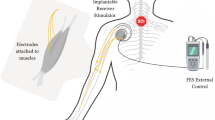Abstract.
Transcranial magnetic stimulation (TMS) allows for quantification of motor system excitability. While routinely used in humans, application in other species is rare and little is known about the characteristics of animal TMS. The unique features of TMS, i.e., predominantly interneuronal stimulation at low intensity and non-invasiveness, are particularly useful in evaluating injury and recovery in animal models. This study was conducted to characterize the rodent motor evoked potential to TMS (MEPTMS) and to develop a methodology for reproducible assessment of motor excitability in the rat. MEPTMS were compared with responses evoked by electrical stimulation of cervical spinal cord (MEPCES) and peripheral nerve. MEP were recorded by subcutaneous electrodes implanted bilaterally over the calf. Animals remained under propofol infusion and restrained in a stereotactic frame while TMS followed by CES measurements were obtained before and after 2 h of idle time. TMS was applied using a 5-cm-diameter figure-of-eight coil. MEPTMS had onset latencies of 6.7±1.3 ms. Latencies decreased with higher stimulation intensity (r=–0.7, P<0.05). Two morphologies, MEPTMS, 1 and MEPTMS, 2, were distinguished by latency of the first negative peak (N1), overall shape, and amplitude. MEPTMS, 2 were more frequent at higher stimulation intensity. While recruitment curves for MEPTMS, 1 followed a sigmoid course, no supramaximal response was reached for MEPTMS, 2. Mid-cervical spinal transection completely abolished any response to TMS. MEPCES showed a significantly shorter latency (5.29±0.24, P<0.0001). Two types of MEPCES resembling MEPTMS, 1 and 2 were observed. Neither MEPTMS nor MEPCES changed on repeat assessment after 2 h. This study demonstrates the feasibility and reproducibility of TMS in the rat. Sigmoid recruitment curves for MEPTMS, 1 suggest input-output properties similar to those of the human corticospinal system. Latency differences between CES and TMS point to a supraspinal origin of the MEPTMS. The two morphologies likely reflect different cortical or subcortical origins of MEPTMS.
Similar content being viewed by others
Author information
Authors and Affiliations
Additional information
Electronic Publication
Rights and permissions
About this article
Cite this article
Luft, A.R., Kaelin-Lang, A., Hauser, TK. et al. Transcranial magnetic stimulation in the rat. Exp Brain Res 140, 112–121 (2001). https://doi.org/10.1007/s002210100805
Received:
Accepted:
Issue Date:
DOI: https://doi.org/10.1007/s002210100805




